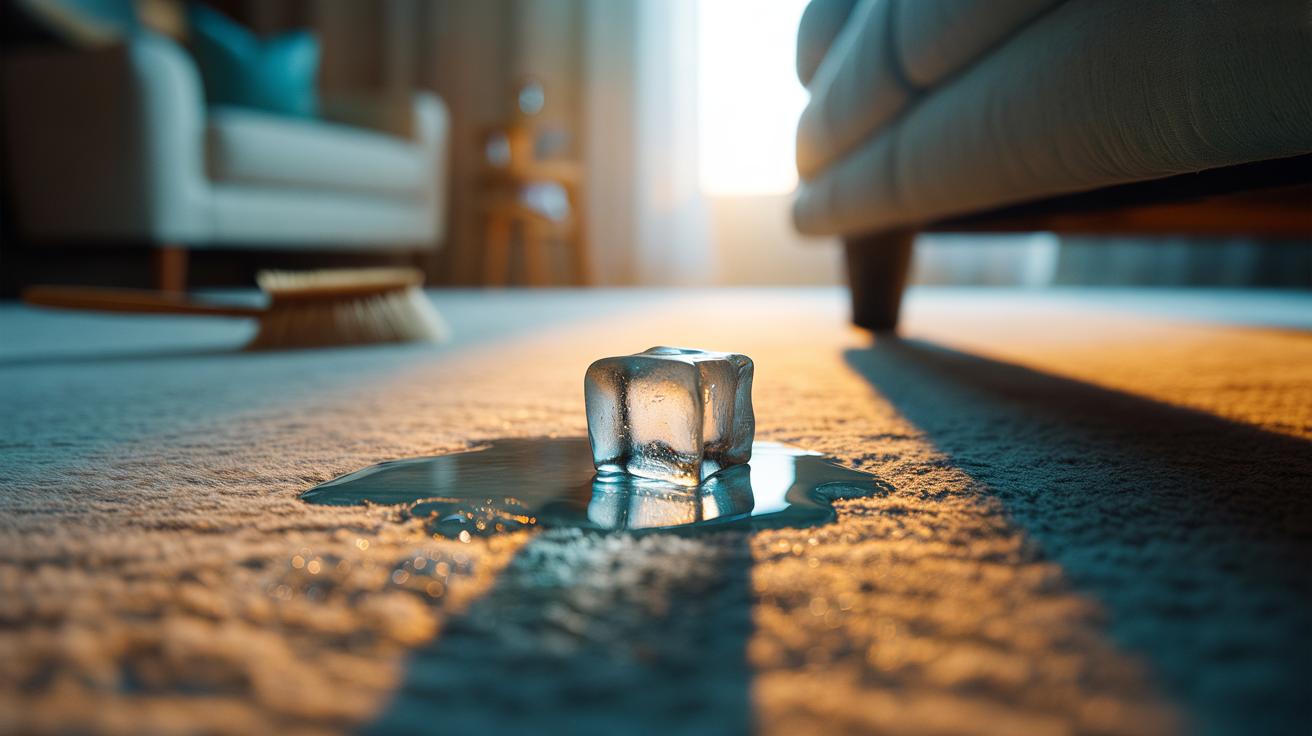In a nutshell
- 🧊 The ice-cube dent trick works by slow melt rehydration: chilled water seeps into the carpet pile, easing micro-kinks, then warms to support a gentle rebound—cool → dampen → relax.
- 🪄 Practical steps: vacuum the dent, place one cube per golf-ball-sized depression, let it melt (30–90 minutes), blot, then lift fibres with a spoon edge or soft brush; finish with airflow for a swift dry.
- 🧵 Fibre-specific tips: nylon and polyester spring back quickly; wool benefits but needs thorough blotting; sisal/jute should be misted sparingly—avoid soaking to prevent staining or puckering.
- ⚠️ Safety and limits: test discreetly, avoid saturating the underlay, and be cautious over unsealed wood; for deep furniture imprints, expect partial recovery or consider professional cleaning.
- 🛡️ Alternatives and prevention: try a distant steamer or warm iron over a damp cloth, use a carpet rake plus cool hairdryer, and prevent dents with wide glides/caster cups, rotations, and regular vacuuming.
The humble ice cube has become an unlikely social media star for rescuing squashed carpets. Far from being a gimmick, the trick relies on slow moisture release and temperature change to coax fibres back to their original loft. As the cube melts, the water seeps into the carpet pile, relaxing compressed strands and rehydrating backing materials that have been under pressure from furniture feet. Slow melt equals slow recovery, giving fibres time to regain their elastic memory. With a light groom and patient drying, the method can soften stubborn dents without harsh heat or chemicals, and it works across many synthetic and wool blends when used carefully.
Why Slow Melting Revives Crushed Fibres
Carpet dents form when concentrated weight deforms the pile and compresses the underlay. An ice cube provides a precise dose of moisture released gradually, not a sudden splash. As chilled water wicks down the fibres, it eases micro-kinks and lubricates yarn filaments, making them more pliable. The cooling phase slightly stiffens the material at first, but the subsequent return to room temperature supports a gentle rebound. This measured cycle—cool, dampen, relax—prevents thermal shock or over-wetting that can set creases rather than lift them. It’s a low-tech form of controlled rehydration, akin to steaming a crumpled garment but without direct heat.
Different piles respond in distinct ways. Nylon and polyester often spring back quickly due to excellent resilience, while wool benefits from moisture’s natural plasticising effect but needs stricter drying to protect the backing. Flatweaves and plant fibres (sisal, jute) can misbehave if flooded, drawing stains or puckering as they dry. The key is dose and time: a standard cube offers a predictable release, letting capillary action do careful work while avoiding the splash-and-hope approach that leaves rings or damp underlay.
A Step-By-Step Guide to the Ice-Cube Dent Trick
Start by clearing the furniture and vacuuming the dent to remove gritty particles that lock fibres down. Place one ice cube directly in the centre; larger dents may need two or three, spaced evenly. As a rule of thumb, use one standard cube per golf-ball-sized depression. Allow it to melt completely—typically 30 to 90 minutes depending on room temperature and pile density. Once the area is damp, blot lightly with a white towel to lift excess moisture, then coax fibres upright using a spoon edge, soft brush, or your fingertips. The motion should be upward and varied to avoid creating a new pattern.
| Fibre Type | Ice Timing | Aftercare |
|---|---|---|
| Nylon | 1 cube, melt fully | Light brush; quick dry |
| Polyester | 1–2 cubes for deep dents | Vacuum lift; minimal blot |
| Wool | 1 cube; monitor closely | Thorough blot; airflow dry |
| Sisal/Jute | Avoid soaking | Spot mist only; test first |
Never saturate the underlay—damp is sufficient to relax fibres. Speed up drying with a fan and open windows to prevent musty odours. If dents persist, repeat once after full drying rather than doubling cubes in one go. Place protective coasters under future furniture to distribute weight and stop the rut from returning.
Safety, Limits, and Smart Alternatives
The ice-cube method is gentle, but it’s not universal. Avoid using it on plant-based flatweaves susceptible to water stains, on carpets with uncertain dye-fastness, or where the subfloor is sensitive to moisture, such as unsealed wood. Slip a barrier towel down if meltwater might track along skirting. Test in a discreet corner before tackling a prominent dent. For heavy imprints—think grand pianos or bookshelves—expect partial rather than perfect recovery. The fibres may need a mix of moisture, grooming, and time, and sometimes professional hot water extraction to reset the pile and rinse trapped soils.
If you’d rather avoid any wetting, try a handheld steamer waved at a distance, or place a damp white cloth over the dent and press briefly with a warm—not hot—iron, lifting and checking often. A carpet rake or upholstery brush can fluff synthetics, while a cool hairdryer assists lift as you tease fibres upright. Prevention still beats cure: rotate furniture seasonally, choose wide glides or caster cups, and vacuum regularly to keep fibres elastic. Consistent, light maintenance preserves loft better than occasional rescue missions.
The ice-cube dent trick endures because it respects how carpets behave: moisture, time, and gentle persuasion win out over brute force. In most UK homes, a couple of cubes, some blotting, and a patient brush restore dignity to flattened patches with minimal fuss. If you take away one mantra, let it be this: slow melt, soft lift, swift dry. From rental flats to family sitting rooms, that simple routine can revive even gloomy furniture shadows. Where might you try it first—and what tweaks will you make to suit your carpet’s character?
Did you like it?4.6/5 (27)
